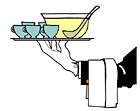|
What is this thing called eggnog and why is it so popular during the holiday season? All across America people want to know, can’t sleep because they don’t. The answer blows not in the wind but lies rather in its place of origin: merry old England, by the most sober accounts. "Nog" was a 17th century word for a kind of strong beer brewed in East Anglia that was used to toast one’s health. It was primarily a luxury of the upper class because in the days before refrigeration all of the dairy farms were on large estates. The milk and eggs were usually mixed with brandy, Madiera or even sherry, but when the drink traveled to Colonial America, rum was more commonly used than the heavily taxed brandy and other spirits.
 In colonial America rum was commonly called "grog." It is more than possible that the name, "Egg Nog" derived from the very description of the drink, "egg-and-grog" which corrupted to "egg n’grog" and, after a few too many, to egg nog. If this version doesn’t sit well, perhaps this next one will. Some experts claim (I would like to see their diplomas) that "nog" derives from "noggin." I don’t mean the synonym for mind or head that somehow got involved in this, but rather a small, wooden, carved mug. It was used to serve drinks at tables in taverns, while drinks beside the fire were presented in tankards. Perhaps the very first eggnog was a mixture of Spanish "sherry" and milk. The English called this concoction "Dry Sack Posset." The truth may lie in a blend of these two stories and after drinking a few, does it really matter? In colonial America rum was commonly called "grog." It is more than possible that the name, "Egg Nog" derived from the very description of the drink, "egg-and-grog" which corrupted to "egg n’grog" and, after a few too many, to egg nog. If this version doesn’t sit well, perhaps this next one will. Some experts claim (I would like to see their diplomas) that "nog" derives from "noggin." I don’t mean the synonym for mind or head that somehow got involved in this, but rather a small, wooden, carved mug. It was used to serve drinks at tables in taverns, while drinks beside the fire were presented in tankards. Perhaps the very first eggnog was a mixture of Spanish "sherry" and milk. The English called this concoction "Dry Sack Posset." The truth may lie in a blend of these two stories and after drinking a few, does it really matter?
Eggnog, also known as "egg flip", became a popular drink throughout early America. It was rich, spicy, alcoholic and available. In the 1820s a man named Pierce Egan, wrote a book called Life of London: The Days and Nights of Jerry Hawthorne and His Elegant Friend, Corinthia Tom. To publicize his work (a formidable task before the days of Madison Avenue), Mr. Egan created a variation of eggnog he dubbed "Tom and Jerry." It added 1/2 ounce of brandy to the basic recipe, which fortified it considerably and added further to its popularity. During the 1800s eggnog was nearly always made in large quantities and served on social occasions. It was commonly displayed in the family’s best punch bowl at holiday parties. According to one English visitor in 1866:

"Christmas is not properly observed unless you brew eggnog for all comers; everyone calls on everyone else and each call is celebrated by a solemn egg-nogging. It is made cold and drunk cold and is to be commended."
Although mostly connected with Christmas, there were other days of the year with an eggnog tradition, so to speak. In colonial America, young men often called upon their friends on New Year’s Day. At each home, each man was offered a cup of nog and thus became more and more inebriated as the day wore on. It is not known how many young men (if any) actually completed their social rounds. Some famous men, too, enjoyed a sip or two of the popular brew. George Washington, the father of our country (sober or not) was so fond of the drink that he concocted his own special recipe that included rye whiskey, rum and sherry. Stiff to say the least, it made crossing the Delaware look easy, although only the most courageous were willing to try (the drink, not crossing the mighty Delaware).
Eggnog by any other name is still a rose, or something like that. Rich, strong eggnog is a big part of New Orleans's holiday traditions. It must, however, take its place beside syllabub on the traditional southern table. For those who think I am referring here to a college course outline, rest assured I am not. Syllabub is a less potent mixture of milk, sugar and wine, but it is just as rich as eggnog and straddles the fattening line between drink and liquid dessert. In Puerto Rico, eggnog is known as "Coquito". Rum is the liquor of choice and there the drink has the added appeal of being made with fresh coconut juice or coconut milk. Mexican eggnog, known as "rompope" was created in the convent of Santa Clara in the state of Pueblo. This recipe includes a heavy dose of Mexican cinnamon and rum or grain alcohol. The resulting brew is sipped as a liqueur. In Peru, the holidays would not be complete without a "biblia con pisco", an eggnog made with the Peruvian brandy known as pisco.
|